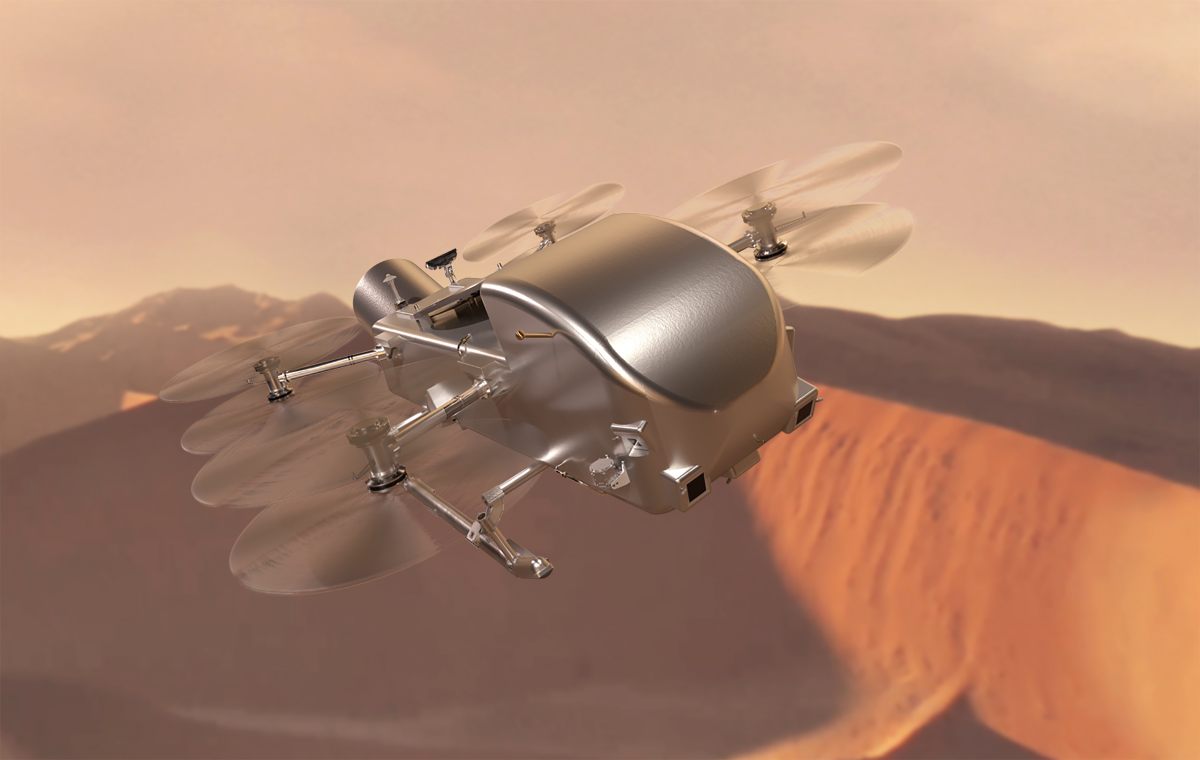Where the Little Helicopter on Mars Fits in the History of Aviation
If the past is any guide, things are going to take off quickly.

Mars is a graveyard for explorers. Many orbiters, landers, rovers, and other mechanical critters that have either been cremated in the Red Planet’s thin atmosphere or fallen silent in the ochre, radiation-smothered sands below, right away or at the end of their technological lifespans. Many belonged to NASA, and the mantra of their droids seems to be: If you’re going to die, you might overachieve before you go.
These robots—the ones that survived their interplanetary journey and arrival intact—all had clear scientific or technological objectives to accomplish before their mechanisms seized up, or their power sources ran dry, perhaps when their solar panels became fully coated in fine dust. But from the late-1990s Mars Pathfinder and the early-2000s Spirit and Opportunity rovers, to the 2010s Curiosity wanderer and the contemporary InSight geophysical mission (which perished in late 2022), so many of them blew right past their mission timelines and operated for months or even years beyond what was expected.
NASA’s Ingenuity Mars Helicopter—affectionately known as Ginny, the first aircraft to achieve powered and controlled flight on another world—is another member of that illustrious club. It was “retired” after a mission-ending injury in January 2024, and the demise of a hard-working and paradigm-shifting robot is cause for a modicum of grief. But its death is, in fact, good news for everyone on Earth. Its exemplary life offers a preview of our trajectory through the wild and wonderful solar system.

Ingenuity was primarily designed to be a demonstration. Everyone wanted to know the answer to a basic query: Can you fly a drone-like machine on Mars? Paired with the Perseverance rover—the first part of a Rube Goldberg–like multi-mission effort to find and deliver pristine rock samples from Mars to Earth—Ingenuity was built to make up to five flights across an alien desert over the course of 30 days. Anything else would be seen as a bonus.
It made 72. Starting April 19, 2021, it traveled 10.5 miles in total—14 times farther than planned. That, frankly, is showing off.
There were a handful of precarious moments during all those aerial sojourns, and flight #72 proved to be too much for the four-pound adventurer. Its previous trip had ended with an emergency landing. Ingenuity’s managers back on terra firma suspected that the onboard software had an issue with the featureless nature of the terrain it was zipping over; the copter itself decided that it couldn’t navigate without any significant landmarks below, so it settled down.

Its handlers ordered another flight—a quick one, simply to pop-up a few dozen feet to regain its bearings and identify its location, with help from Perseverance, which acts as a communications relay for the copter. But as it flew, it tragically lost contact with its partner. Once comms were re-established the next day, it was revealed that one of Ingenuity’s rotor blades was irreparably damaged. The cause of the accident is still being investigated, but the prognosis was clear and unmistakable: Ginny would never fly again.
Ingenuity was more than a rudimentary remote-controlled drone. The communications lag of several minutes between Mars and Earth means that flight orders could be sent to the copter, but it essentially had to pilot itself. A collection of clever algorithms let it autonomously navigate and choose its own landing sites. Atmospheric conditions on Mars are also noticeably different from those on Earth, so the algorithms had to account for thinner, carbon dioxide–packed air. Thought to be capable only of safely operating during the warmer Martian spring, Ginny also managed to survive in darker, frigid winter conditions, with temperatures as low as minus 112 Fahrenheit, and even worked through repeated freezing and thawing of its computational brain.
These remarkable achievements unquestionably fit within the pantheon of history’s aerial milestones. It’s easy to compare it to the Wright Brothers’ first airplane flight—a mere 12 seconds—on December 17, 1903, in Kitty Hawk, North Carolina.
Imagine, just for a second, what it was like to be part of the first hot-air balloon flight way back on September 19, 1783. Joseph-Michael and Jacques-Ètienne Montgolfier, two French paper manufacturers, designed the balloon but wisely didn’t hop in themselves. Instead, a sheep, duck, and rooster were placed in the wicker basket, and, to the astonishment of thousands of onlookers in Versailles, including King Louis XVI, soared nearly 2,000 feet in the air and then softly landed minutes later, intact but presumably bemused. Later that year, Jean-François Pilâtre de Rozier, a science teacher, was the first person to fly in a hot-air balloon—the first to see the world, albeit tethered to the ground, from above (at least without the help of a vertiginous mountain).
Those two achievements—the first hot-air balloon flight and the first airplane flight—were just the beginning of an explosion. It stuns me to no end that the first nonstop flight across the Atlantic Ocean happened in 1919, less than two decades after Kitty Hawk, quickly followed by the first aerial circumnavigation of the planet in 1924. The stratosphere, the layer of the atmosphere above the one we all experience (the troposphere), was breached in 1931 by a high-altitude hot-air balloon, a flight whose occupants—Swiss physicist August Piccard and assistant Charles Kipfer—enjoyed for 17 long hours up there.
The U.S. Air Force got one of their pilots to fly faster than the speed of sound in 1947. The first transatlantic jet passenger service got going in 1958. And humans landed on the lunar surface for the first time in 1969.
Many of these efforts were driven by showmanship, the desire to do something new, with flair. Others were fueled by one-upsmanship. But to varying degrees, they were all also about advancing the human need to have its questions about nature and the cosmos answered. Could animals, including humans, survive at unfathomable altitudes, or at breakneck speeds? Could we break the chains of gravity and step foot on another celestial isle in the sea of stars?

Like all these game-changing moments, what Ingenuity accomplished was revelatory, and for this moment, entirely novel. Look at where those preceding aerial marvels quickly led us—and consider how commonplace such feats are today. Yes, they have also led to suffering: Powered flight (and, eventually, autonomous flight with drones) revolutionized our ability to wage war, often asymmetrically, against enemies real or perceived. The climate crisis is not helped by our addiction to aviation. But history’s milestones in flight have also transformed our exploratory capabilities.
Ingenuity accomplished its mission, and now powered, autonomous aircraft for Mars are currently being designed—and in some cases, tested on Earth—to act as scouts for more heavily instrumented rovers, a force multiplier for the science they can conduct. Should the rover head toward that ancient river delta to look for signs of past or present life, or should it head toward that volcanic field, one whose subterranean heat stores may still be stirring? It’s likely that Ingenuity’s successors will also come with drilling and scooping tools of their own, to thieve little geologic curiosities and bring them back to their rover—or, eventually, astronaut—for forensically detailed analysis.

And the missions don’t stop at Mars. Scientists are already at work on Dragonfly, a dual-quadcopter powered by a small nuclear reactor designed to flit across the muddy, hazy surface of Titan, a deeply mysterious Saturnian moon, to ascertain its microbial habitability. What a joy it would be to travel back in time and tell those paper manufacturers piecing together their hot-air balloon that, one day, not terribly far in the future, a sun-powered robotic ambassador would fly over Mars on its own, and then another machine, harnessing the power of the building blocks of matter, could voyage through even more distant and alien skies.
Ingenuity, today, is extraordinary. Soon, it will seem ordinary, and our sense of wonder will have expanded its frontier.
Robin George Andrews is a doctor of volcanoes, an award-winning freelance science journalist, and the author of two books: Super Volcanoes: What They Reveal About Earth and the Worlds Beyond (2021), and the upcoming How to Kill an Asteroid: The Absurd True Story of the Scientists Defending the Planet (2024).























Follow us on Twitter to get the latest on the world's hidden wonders.
Like us on Facebook to get the latest on the world's hidden wonders.
Follow us on Twitter Like us on Facebook